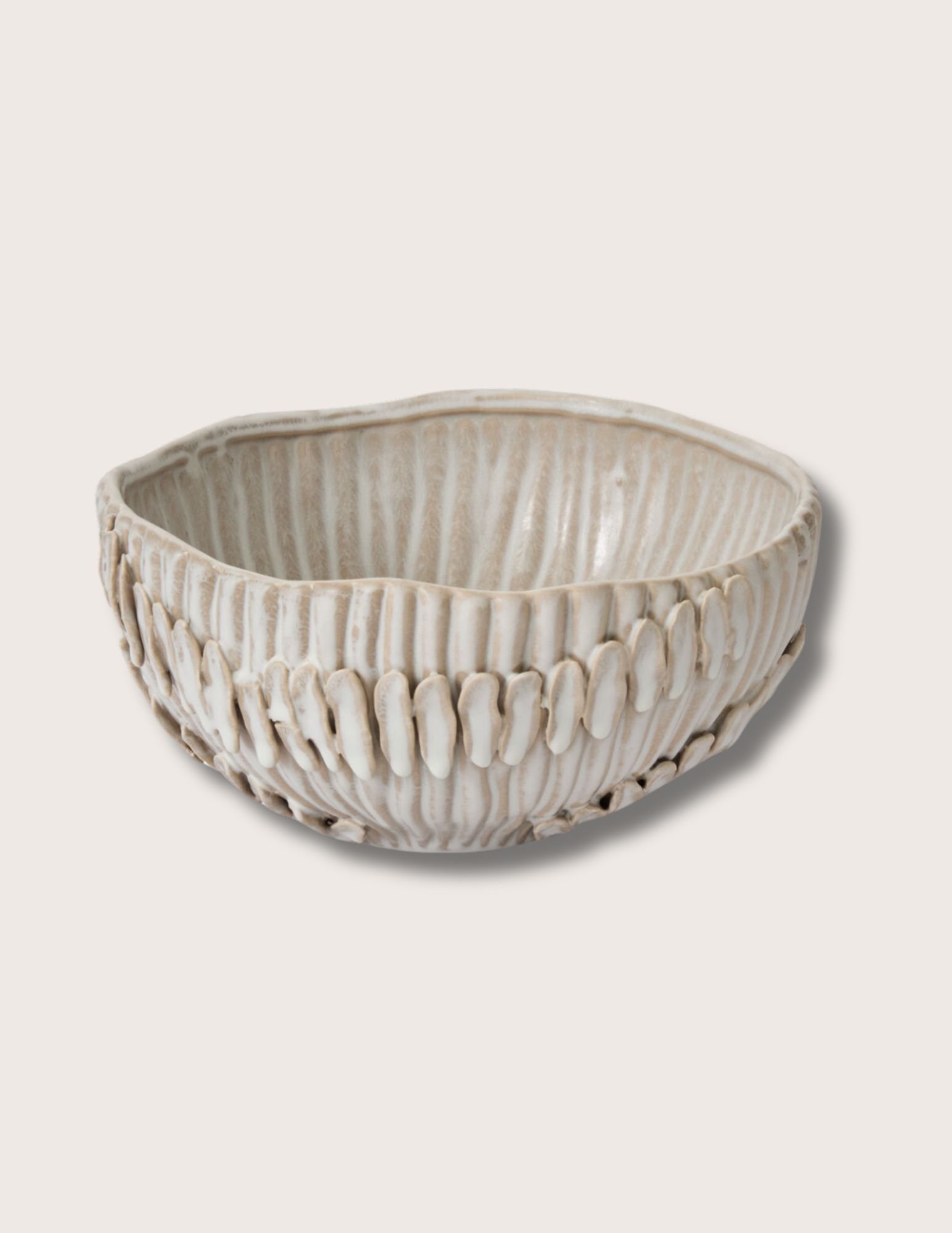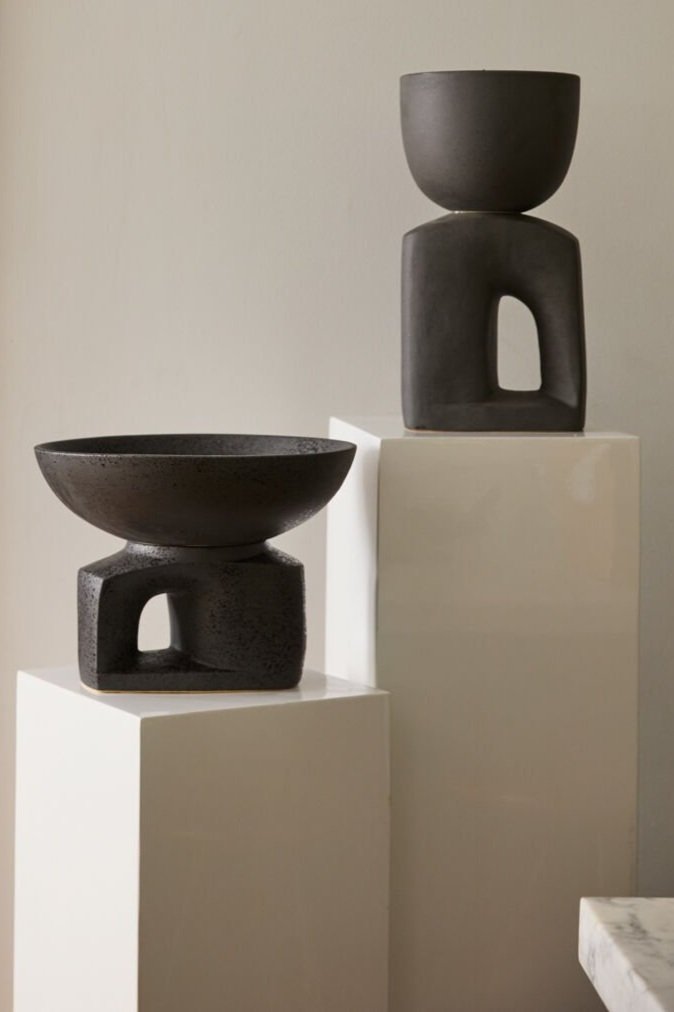 Image 1 of 2
Image 1 of 2

 Image 2 of 2
Image 2 of 2



Meroë Petal Bowl
Details
Give your coffee table and shelf displays an upgrade with the sculptural form and stunning shape of the Meroë Petal Bowl in black. Cast in aluminum the large open petal shapes extend from the central base, curving upwards, and stop at varying heights. This versatile piece can be styled with fruit as kitchen decor, on its own as a decorative object, filled with a moss layer for an orchid or other planting, or pair it on a console with the Meroë Candle Holder for a sophisticated look.
Editors' Note
Metalwork has been an important part of African culture since Egypt’s Old Kingdom period (2686-2181 BC). Ironworking has an even longer history in Africa as currently, the oldest iron artifacts in the world are nine small beads found at burial sites in Gerzah, Egypt, and which date to 3200 BC. The crafting of the beads, made from meteoritic iron, suggest that African ironsmiths were skilled in working meteoritic iron long before iron-smelting developed — throughout the continent — in the first millennium BC. The ancient city of Djenné-Djenno (present-day Mali), which stood from the 3rd century BC to the 12th century AD in and the Nok (Northern Nigeria) also developed iron-working capabilities during this time. Also in the 3rd century BC, the city of Meroë, capital of the kingdom of Kush (Sudan) highlighted iron-smelting as its main industry. Later, the kingdom of Askum (Ethiopia/Eritrea), the Kamilamba (DRC), Campo (Cameroon) and Great Zimbabwe also developed sophisticated methodologies of their own. While it is often supposed that iron-smithing technology was imported to Africa from Europe — particularly south of the Sahara — evidence shows that contemporary furnace technology on the two continents circa 400-200 BC was markedly different, with African metallurgists fielding a far wider range of sophisticated furnace types, capable of meeting a broader range of needs. Moreover, iron-working has been historically linked to the many cultures linguistically grouped and collectively described as “Bantu,” though it remains debated whether the technology spread from the Bantu as a central source, or whether the various methods developed independently. As the trans-Atlantic slave trade transported people and knowledge to the Americas, enslaved ironworkers were highly prized and widely employed, most utilizing knowledge created and developed in their homelands or, later, passed on from their ancestors. Creating pieces ranging from the purely functional to the highly decorative, these artisans continued to develop and innovate new techniques, often only to be removed from the story of their development. The well-known Cort process for creating wrought iron, named for the banker Henry Cort, who patented it, and hailed as one of the most important innovations of the British Industrial Revolution, was in fact the invention of enslaved blacksmiths in Jamaica. Though the process helped make Britain a leading iron exporter of the time, the role of 76 enslaved Jamaican ironsmiths in its invention has only recently come to light. Yet despite their skill, following the end of slavery in America, skilled Black ironsmiths found themselves excluded from unions and employment, fueling the mythology that Africa had no history with iron and that Black workers lacked the “innate abilities” needed for the craft.
Details
Give your coffee table and shelf displays an upgrade with the sculptural form and stunning shape of the Meroë Petal Bowl in black. Cast in aluminum the large open petal shapes extend from the central base, curving upwards, and stop at varying heights. This versatile piece can be styled with fruit as kitchen decor, on its own as a decorative object, filled with a moss layer for an orchid or other planting, or pair it on a console with the Meroë Candle Holder for a sophisticated look.
Editors' Note
Metalwork has been an important part of African culture since Egypt’s Old Kingdom period (2686-2181 BC). Ironworking has an even longer history in Africa as currently, the oldest iron artifacts in the world are nine small beads found at burial sites in Gerzah, Egypt, and which date to 3200 BC. The crafting of the beads, made from meteoritic iron, suggest that African ironsmiths were skilled in working meteoritic iron long before iron-smelting developed — throughout the continent — in the first millennium BC. The ancient city of Djenné-Djenno (present-day Mali), which stood from the 3rd century BC to the 12th century AD in and the Nok (Northern Nigeria) also developed iron-working capabilities during this time. Also in the 3rd century BC, the city of Meroë, capital of the kingdom of Kush (Sudan) highlighted iron-smelting as its main industry. Later, the kingdom of Askum (Ethiopia/Eritrea), the Kamilamba (DRC), Campo (Cameroon) and Great Zimbabwe also developed sophisticated methodologies of their own. While it is often supposed that iron-smithing technology was imported to Africa from Europe — particularly south of the Sahara — evidence shows that contemporary furnace technology on the two continents circa 400-200 BC was markedly different, with African metallurgists fielding a far wider range of sophisticated furnace types, capable of meeting a broader range of needs. Moreover, iron-working has been historically linked to the many cultures linguistically grouped and collectively described as “Bantu,” though it remains debated whether the technology spread from the Bantu as a central source, or whether the various methods developed independently. As the trans-Atlantic slave trade transported people and knowledge to the Americas, enslaved ironworkers were highly prized and widely employed, most utilizing knowledge created and developed in their homelands or, later, passed on from their ancestors. Creating pieces ranging from the purely functional to the highly decorative, these artisans continued to develop and innovate new techniques, often only to be removed from the story of their development. The well-known Cort process for creating wrought iron, named for the banker Henry Cort, who patented it, and hailed as one of the most important innovations of the British Industrial Revolution, was in fact the invention of enslaved blacksmiths in Jamaica. Though the process helped make Britain a leading iron exporter of the time, the role of 76 enslaved Jamaican ironsmiths in its invention has only recently come to light. Yet despite their skill, following the end of slavery in America, skilled Black ironsmiths found themselves excluded from unions and employment, fueling the mythology that Africa had no history with iron and that Black workers lacked the “innate abilities” needed for the craft.

Additional Details
Single bowl
Weight: 5.5 lbs
Material: Metal
Opening Size: 15"x 13"
Dimensions: 16.25” x 14.25” x 9.5”
Made to order
Ships within the continental US in 7-10 business days











